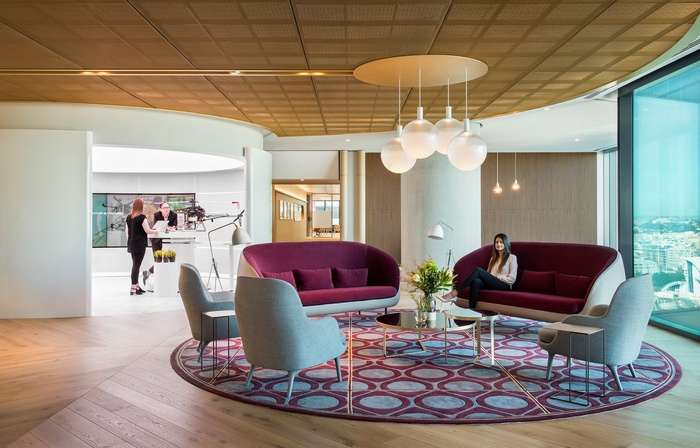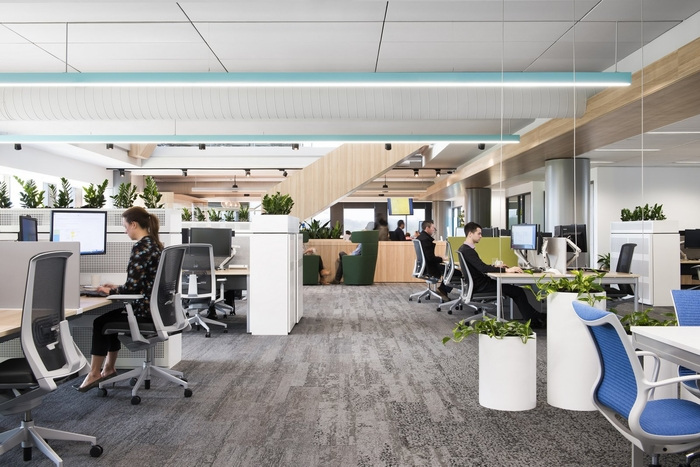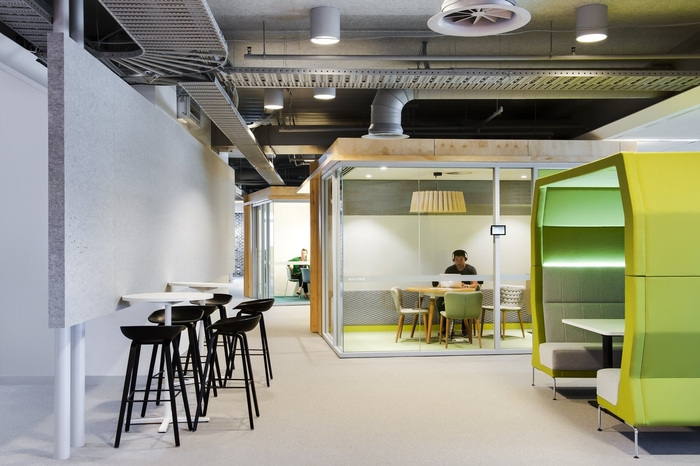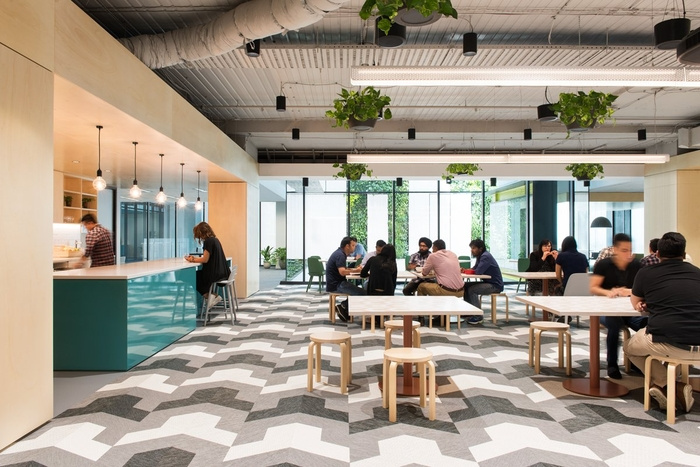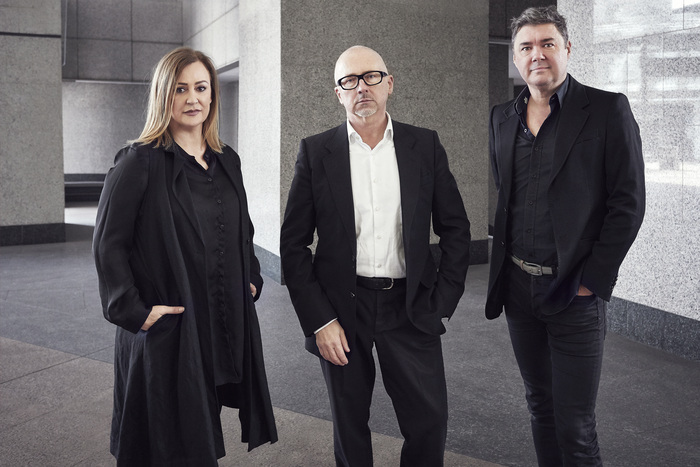
The Intro: Getting to Know Futurespace
Founded in 2001, Futurespace is a leading interior design firm from Australia led by Angela Ferguson, Stephen Minnett, and Gavin Harris (pictured above left to right).
You know Futurespace as the name behind the offices of companies like Microsoft, PwC, REA Group, and PEXA. We recently had a chance to catch up with them in order to learn more about their practice, to shed a little light on office design in Australia, and to find out more about the changing models of workplace design.
Why the name Futurespace? Can you tell us a little bit about how the firm came to be?
Angela Ferguson: Futurespace is about our commitment to design and research when it comes to understanding how people use space now, and how they will use space far into the future. At Futurespace we believe that people are the product of their environment, and this is why I personally became a designer: because I somehow inherently knew that I could improve people’s lives through the spaces they inhabit.
In western society we spend about 90% of our lives indoors so it stands to reason then that interior design can have a significant impact on people’s physical and emotional wellbeing.
Stephen Minnett: When we founded Futurespace we wanted a name that reflected what we did – not who we were. Most design practices use people’s names but we felt that the name should say more than who was working there. We believe that space has a profound effect on people’s lives and how happy and productive they are and the genesis of the name Futurespace was our interest in the future of the workplace.
Waiting area from the recently completed PwC Sydney Offices / photo by Nicole England
What has changed in the field of office design since the firm was founded in 2001?
AF: Workplace design is about providing environments that support people’s behaviours. Since 2001 the way we work has changed quite dramatically; largely driven by technology. Some of the most significant technological changes have happened in people’s lives since 2001 (like Facebook in 2005 and the iphone in 2007) and so the way we work today is much more agile, much more mobile. The physical space is still very important though for people to come together , which has really changed the meaning of the workplace.
Workplaces today are much more diverse than they ever have been in the past, with a much bigger range of settings and choice available for all employees.
Gavin Harris: Commercial Interior Design, is more interesting and strategic than it ever has been. Companies see the importance the workplace makes to their business in employers choice, retention of staff, projection of the business to the general public, health of their people. Finally the ability of their workplace to be able to adopt/change to changing business conditions – seen and unseen.
SM: Australia has been at the forefront of the development of new more agile ways of working. While early projects we undertook with the implementation of Activity Based Workplaces (ABW) were seen as radical at the time they have become the mainstream in Australia. Our clients are now seeking an intelligent evolution of those early ABW into new hybrid models.
What areas are you most interested in exploring as a practice? Are there any areas you’re not interested in?
AF: I am passionate about projects that improve people’s lives. So whether that is a healthy workplace, a residential tower that creates community or a hotel that embodies the best of what its host city has on offer – then these are the type of projects we work on at Futurespace. Design doesn’t have to cost a lot, it’s about the small details that promote collaboration, health and wellbeing, engagement and empowerment and that really make a big difference in people’s everyday experiences either at work, home or school.
In terms of workplace, there is no one sector we prefer. Rather, it’s the clients who understand that good design equals good business who are most aligned with what Futurespace provides for clients.
Can you give us a feeling for what office design in Australia is like? Are there any traits of Australian office design which the rest of the world can learn from?
AF: Australia is generally considered to be at the forefront of global workplace design innovation, leading other countries such as Asia, much of Europe (other than the Netherlands) and North America when it comes to responding to changes in people’s work styles and behaviour, and in delivering design solutions to support these changes.
‘Work’ is somewhere we spend about a third of our lives and the Australian work week is one of the longest in the world. Quite often employees will spend more time working than sleeping. So it’s important that the physical environment in which we work is a place that supports and engages its people. In addition to designing modern, agile, provocative workplace, Australia does the connection to the outdoors really well. ‘No hierarchy’ is also something we are great at – we have a reputation for egalitarianism, accessibility to our superiors, and very flat management structures in many organisations.
In the last 5 years, as technology has become even more dominant in our working lives, our work days are no longer 9 to 5 and have in fact become 24/7 – therefore high performing, intelligent workplaces are more important than ever.
At Futurespace know that people are the product of their environment, and one of the most important places to recognise this is in the workplace.
SM: Office design in Australia is currently booming in cities like Sydney and Melbourne where the economy is strong. Increasingly Australian workplace design expertise is sort out by other countries in the region as our early adoption of more flexible and agile work environments is seen as the way forward.
GH: Office design in Australia is picking up and reflecting all the great elements from hospitality, retail and domestic design. Workplaces are being coming more relaxed in their furnishings ( like home), but still supporting good work behaviors and services. Reception desks are disappearing and being replaced with concierge type welcome lounges for both visitors and staff. Cafe’s and self served restaurants that are for both clients and staff, supporting working in the open and in collaboration.
Open work environment from AztraZeneca’s Sydney offices / photo by Nicole England
Several of your recent projects like MYOB, AstraZeneca, or REA Group have been agile or more flexible in nature. Can you describe this idea and it differs from a traditional office design?
AF: The underlying philosophies of ‘activity based working’ or ‘agile working’ include;
- freedom, sustainability and empowerment;
- a greater variety of choice for both individuals and teams
- increased productivity and engagement
- increased transparency and collaboration
- an autonomous workplace with reduced turnover and reduced illness
- increased agility and co-creation
- greater speed to market and flexibility of products and services
- increased ability to respond to market change and disruption
The main difference between an agile environment and a traditional environment is that it is a bespoke response – all agile briefs are very different – and there is no such thing as a cookie cutter workspace.
SM: Traditional office design is inflexible and biased towards individual workpositions (either in the open plan or in enclosed offices) Our clients are finding that those traditional models no longer support the more agile way their people are seeking to work in. The key to these new flexible models is choice. The choice to work where and how you want so you can be most effective- with better support for both individual focussed work as well as collaborative work (either team based or between 2 people)
Flexible space from the agile offices of REA Group in Melbourne / photo by Nicole England
Office Snapshots mainly publishes the initial concepts and implementation of a design. Can you help us get a sense of what makes for a successful design after the initial stages? Can it be measured?
AF: Engagement is perhaps the best measure of a workplace’s success. Futurespace has a number of ways we collect data, beyond anecdotal, that demonstrate which spaces are the most successful, where and how people are most productive, and how the environment supports a range of different workstyles from quiet, focussed arechtypes to more collaborative ways of working. Obviously you can’t tell these things from photos, and its important that publications likes Office Snapshots tell these stories as well – beyond just what a project looks like.
SM: The key to measuring the success of a design is to undertake rigorous measurement of the performance of a workplace BEFORE the implementation of a new model. That then gives you a base case for assessing the success of the new design. With the growing complexity of new agile solutions there is a need for ongoing engagement to support the evolution of the design to support the evolution of the business it supports
Cafeteria from PEXA’s Melbourne offices / photo by Nicole England
What projects is Futurespace currently working on?
AF: Currently we are working on projects for SBS Television, M&C Saatchi advertising and a range of technology companies.
SM: New workplace projects for M&C Saatchi (advertising), Johnson & Johnson (pharmaceutical), PWC (professional services), IRESS (fintech), TBS (charity), Microsoft (technology), REA.com (on-line real estate), SBS (media)
And lastly, can you each describe your ideal work environment and where we would most likely find you when you’re not working?
AF: My ideal working environment has fresh air, great connection to the outdoors, is neat and tidy and looks gorgeous. It also has to be very practical, with spaces for me to collaborate with the team but also to have quiet, private meetings or take a phone call. It also needs somewhere for my dog Scout to sleep! Which is pretty much our current office environment at Futurespace.
There is never really a time when I am not working, as I love what I do and I am always thinking or reading about design. When I am not in the studio though I am either outdoors at the beach or in a park or travelling around the world, speaking and presenting on the work that Futurespace does!
SM: My ideal working environment would be a studio space in the city that was a beautiful calm oasis in the middle of a vibrant exciting neighbourhood with great cafes, restaurant, shops and cultural amenities
GH: I like a large table to work on, for drawing on over sized paper. I can layout out all my drawing equipment and place the iPad on the side if I need to research some items. I like being able to see a number of projects at a time, they feed to thinking. If I am not at the table I’m sitting on the lounge or kitchen table with the children.
Thank you!
You can connect with Futurespace on their website, on Facebook, Twitter, Instagram, LinkedIn, and browse their projects on Office Snapshots.
